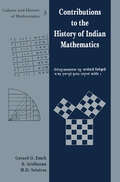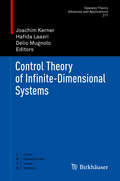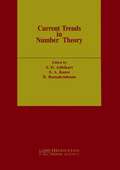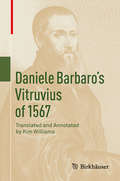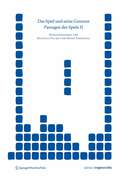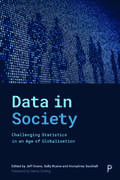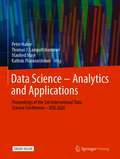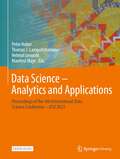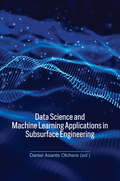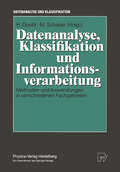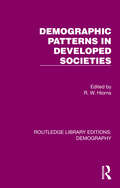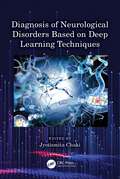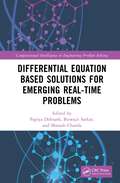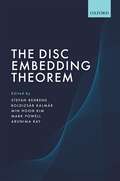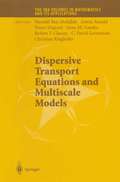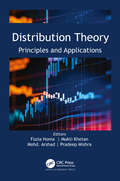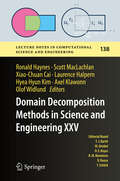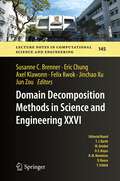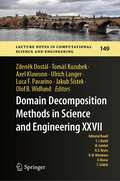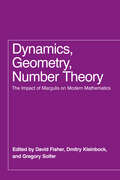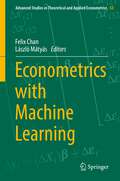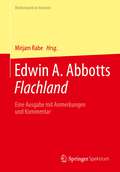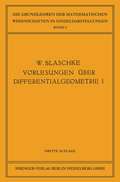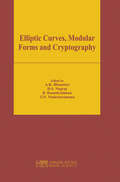- Table View
- List View
Contributions to the History of Indian Mathematics (Culture And History Of Mathematics #3)
This volume consists of a collection of articles based on lectures given by scholars from India, Europe and USA at the sessions on 'History of Indian Mathematics' at the AMS-India mathematics conference in Bangalore during December 2003. These articles cover a wide spectrum of themes in Indian mathematics. They begin with the mathematics of the ancient period dealing with Vedic Prosody and Buddhist Logic, move on to the work of Brahmagupta, of Bhaskara, and that of the mathematicians of the Kerala school of the classical and medieval period, and end with the work of Ramanaujan, and Indian contributions to Quantum Statistics during the modern era. The volume should be of value to those interested in the history of mathematics.
Control Theory of Infinite-Dimensional Systems (Operator Theory: Advances and Applications #277)
This book presents novel results by participants of the conference “Control theory of infinite-dimensional systems” that took place in January 2018 at the FernUniversität in Hagen. Topics include well-posedness, controllability, optimal control problems as well as stability of linear and nonlinear systems, and are covered by world-leading experts in these areas. A distinguishing feature of the contributions in this volume is the particular combination of researchers from different fields in mathematics working in an interdisciplinary fashion on joint projects in mathematical system theory. More explicitly, the fields of partial differential equations, semigroup theory, mathematical physics, graph and network theory as well as numerical analysis are all well-represented.
Daniele Barbaro’s Vitruvius of 1567
This is the first-ever English translation of Daniele Barbaro’s 1567 Italian translation of and commentary on Vitruvius’s Ten Books of Architecture, an encyclopaedic treatment of science and technology whose influence extended far beyond its day. Intended to both interpret and expand upon the Vitruvian text, Barbaro’s erudite commentary reflects his Aristotelian approach, particularly his fascination with the relationship between science and the arts. This treatise offers a window onto the architectural ideals of the 1500s, as well as then-current notions of philosophy, mathematics, music, astronomy, mechanics, and more. The text is accompanied by illustrations by the Renaissance architect Andrea Palladio and his contemporaries. Palladio’s own Four Books on Architecture, published in 1570, was just one of many treatises on architecture that was inspired by the ideas contained here.An overview of Daniele Barbaro’s thinking is presented in a foreword by Branko Mitrovic´. The collocation of Barbaro’s treatise between those of Alberti and Palladio is addressed in a foreword by Robert Tavernor. Kim Williams provides a translator’s note to orient the reader. The text of the translation is cross-referenced to both Barbaro's 1567 publication and standard divisions of Vitruvius. The volume includes a detailed index of subjects and an index of proper names.
Das Spiel und seine Grenzen: Passagen des Spiels II (Edition Angewandte)
Spiel ist heute ins Zentrum der Kulturwissenschaften gerückt. In seinen Regeln, seinem Design und den Erzählungen, die es generiert, ist Spiel die Arena gesellschaftspolitischer und ästhetischer Konflikte und der ökonomisch bedeutendste Sektor der Freizeit- und Bewusstseinsindustrie der Gegenwart.Die Konjunktur des Spielbegriffs kennzeichnet den Übergang einer Erwerbs- und Leistungsgesellschaft zu einer Chancen- und Risikogesellschaft. Doch: Wer spielt? Wer gewinnt und wer verliert? Wer bestimmt die Regeln des Spiels?„Das Spiel und seine Grenzen" untersucht kritisch die Struktur und Grenzen des Spiels in der Kunst, Philosophie, Kulturindustrie und Ökonomie im 20. und zu Beginn des 21. Jahrhunderts.Die Beiträge sind den spieltheoretischen Werken und Anmerkungen unter anderem bei Johan Huizinga, Theodor W. Adorno und Sigmund Freud gewidmet. Betrachtet werden aber auch die Spiel-Räume in Städten und in den Multiplayer Online Welten des Internet, das Verhältnis von Spiel und Kunst bei Marcel Duchamp, in der Performance Art und im Kriminalroman sowie – last not least – das Spiel mit dem Geld im Hazardkapitalismus der unmittelbaren Gegenwart.
Data in Society: Challenging Statistics in an Age of Globalisation
Data is a social phenomenon. This book examines the ways in which we are constantly engaging with data, consciously through the ways in which we provide data about ourselves and without awareness. It analyses the construction and use of statistics by governmental and non-governmental organisations, looking at how statistics are used in social discourse to advance interests and to achieve particular, often political ends. The authors also consider the increasing power of private corporations and transnational organisations, including recent processes affecting the ownership and access to data, as well as the importance of data in uncovering and portraying injustices.
Data Science – Analytics and Applications: Proceedings of the 3rd International Data Science Conference – iDSC2020
Organisationen sind bereits von der starren Struktur des klassischen Projektmanagements zu agilen Ansätzen übergegangen. Dies gilt auch für Softwareentwicklungsprojekte, die flexibel sein müssen, um schnell auf die Wünsche der Kunden reagieren zu können und um Änderungen zu berücksichtigen, die aufgrund von Architekturentscheidungen erforderlich sind. Nachdem sich die Datenwissenschaft als Eckpfeiler in Organisationen und Unternehmen etabliert hat, ist es nun zwingend erforderlich, diesen entscheidenden Schritt auch für analytische Geschäftsprozesse durchzuführen. Die nicht-deterministische Natur der Datenwissenschaft und die ihr innewohnenden analytischen Aufgaben erfordern einen interaktiven Ansatz für eine evolutionäre, schrittweise Entwicklung zur Realisierung der wichtigsten Geschäftsanwendungen und Anwendungsfälle.Die 3. Internationale Konferenz zur Datenwissenschaft (iDSC 2020) brachte Forscher, Wissenschaftler und Wirtschaftsexperten zusammen, um Möglichkeiten zu erörtern, wie neue Wege zur Umsetzung agiler Ansätze in den verschiedenen Bereichen der Datenwissenschaft, wie maschinelles Lernen und KI, Data Mining oder Visualisierung und Kommunikation, sowie Fallstudien und Best Practices von führenden Forschungseinrichtungen und Wirtschaftsunternehmen etabliert werden können.Der Tagungsband umfasst alle im wissenschaftlichen Track vorgestellten Volltexte und die Kurzbeiträge aus dem studentischen Track.Zu den Themen, die Sie interessieren, gehören unter anderem: Künstliche Intelligenz und Maschinelles Lernen Implementierung von Data-Mining-Prozessen Agile Datenwissenschaft und Visualisierung Fallstudien und Anwendungen für Agile DatenwissenschaftOrganizations have moved already from the rigid structure of classical project management towards the adoption of agile approaches. This holds also true for software development projects, which need to be flexible to adopt to rapid requests of clients as well to reflect changes that are required due to architectural design decisions. With data science having established itself as corner stone within organizations and businesses, it is now imperative to perform this crucial step for analytical business processes as well. The non-deterministic nature of data science and its inherent analytical tasks require an interactive approach towards an evolutionary step-by-step development to realize core essential business applications and use-cases.The 3rd International Data Science Conference (iDSC 2020) brougt together researchers, scientists, and business experts to discuss means of establishing new ways of embracing agile approaches within the various domains of data science, such as machine learning and AI, data mining, or visualization and communication as well as case studies and best-practices from leading research institutions and business companies.The proceedings include all full papers presented in the scientific track and the short papers from the student track.Among the topics of interest are:Artificial Intelligence and Machine Learning Implementation of data mining processes Agile Data Science and Visualization Case Studies and Applications for Agile Data Science
Data Science – Analytics and Applications: Proceedings of the 4th International Data Science Conference – iDSC2021
Organizations have moved already from the rigid structure of classical project management towards the adoption of agile approaches. This holds also true for software development projects, which need to be flexible to adopt to rapid requests of clients as well to reflect changes that are required due to architectural design decisions. With data science having established itself as corner stone within organizations and businesses, it is now imperative to perform this crucial step for analytical business processes as well. The non-deterministic nature of data science and its inherent analytical tasks require an interactive approach towards an evolutionary step-by-step development to realize core essential business applications and use cases.The 4th International Data Science Conference (iDSC) 2021 brought together researchers, scientists, and business experts to discuss means of establishing new ways of embracing agile approaches within the various domains of data science, such as machine learning and AI, data mining, or visualization and communication as well as case studies and best practices from leading research institutions and business companies.The proceedings include all full papers presented in the scientific track and the corresponding German abstracts as well as the short papers from the student track.Among the topics of interest are:Artificial Intelligence and Machine Learning Implementation of data mining processes Agile Data Science and Visualization Case Studies and Applications for Agile Data Science---Organisationen sind bereits von der starren Struktur des klassischen Projektmanagements zu agilen Ansätzen übergegangen. Dies gilt auch für Softwareentwicklungsprojekte, die flexibel sein müssen, um schnell auf die Wünsche der Kunden reagieren zu können und um Änderungen zu berücksichtigen, die aufgrund von Architekturentscheidungen erforderlich sind. Nachdem sich die Datenwissenschaft als Eckpfeiler in Organisationen und Unternehmen etabliert hat, ist es nun zwingend erforderlich, diesen entscheidenden Schritt auch für analytische Geschäftsprozesse durchzuführen. Die nicht-deterministische Natur der Datenwissenschaft und die ihr innewohnenden analytischen Aufgaben erfordern einen interaktiven Ansatz für eine evolutionäre, schrittweise Entwicklung zur Realisierung der wichtigsten Geschäftsanwendungen und Anwendungsfälle.Die 4. Internationale Konferenz zur Datenwissenschaft (iDSC 2021) brachte Forscher, Wissenschaftler und Wirtschaftsexperten zusammen, um Möglichkeiten zu erörtern, wie neue Wege zur Umsetzung agiler Ansätze in den verschiedenen Bereichen der Datenwissenschaft, wie maschinelles Lernen und KI, Data Mining oder Visualisierung und Kommunikation, sowie Fallstudien und Best Practices von führenden Forschungseinrichtungen und Wirtschaftsunternehmen etabliert werden können.Der Tagungsband umfasst alle im wissenschaftlichen Track vorgestellten Volltexte und die Kurzbeiträge aus dem studentischen Track auf Englisch und die dazugehörigen Abstracts auf Deutsch.Zu den Themen, die sie interessieren, gehören unter anderem: Künstliche Intelligenz und Maschinelles Lernen Implementierung von Data-Mining-Prozessen Agile Datenwissenschaft und Visualisierung Fallstudien und Anwendungen für Agile Datenwissenschaft
Data Science and Machine Learning Applications in Subsurface Engineering
This book covers unsupervised learning, supervised learning, clustering approaches, feature engineering, explainable AI and multioutput regression models for subsurface engineering problems. Processing voluminous and complex data sets are the primary focus of the field of machine learning (ML). ML aims to develop data-driven methods and computational algorithms that can learn to identify complex and non-linear patterns to understand and predict the relationships between variables by analysing extensive data. Although ML models provide the final output for predictions, several steps need to be performed to achieve accurate predictions. These steps, data pre-processing, feature selection, feature engineering and outlier removal, are all contained in this book. New models are also developed using existing ML architecture and learning theories to improve the performance of traditional ML models and handle small and big data without manual adjustments. This research-oriented book will help subsurface engineers, geophysicists, and geoscientists become familiar with data science and ML advances relevant to subsurface engineering. Additionally, it demonstrates the use of data-driven approaches for salt identification, seismic interpretation, estimating enhanced oil recovery factor, predicting pore fluid types, petrophysical property prediction, estimating pressure drop in pipelines, bubble point pressure prediction, enhancing drilling mud loss, smart well completion and synthetic well log predictions.
Datenanalyse, Klassifikation und Informationsverarbeitung: Methoden und Anwendungen in verschiedenen Fachgebieten (Datenanalyse und Klassifikation)
Der vorliegende Band umfaJ3t 24 Artikel, fiir die ingesamt 31 Autoren verantwortlich zeichnen. Es handelt sich dabei - mit Ausnahme des (von Herausgeberseite in Auf trag gegebenen) Beitrags von P. Simons - um Referate, die anlafilich der 15. Jahrestagung der Gesellschaft fiir Klassifikation an der Universitat Salzburg (Institut fiir Romanistik) in der Zeit vom 25. bis zum 27. Februar 1991 gehalten worden waren. Das wissenschaftliche Motto dieser Tagung lautete: Klassifikation, Datenanalyse und Informationsverarbeitung. Herausforderung fur die interdisziplinare Forschung. Tatsachlich deckten die mehr als 100 im Rahmen von Plenar- sowie Sektionsvortragen und von Workshops prasentierten Beitrage thematisch ein sehr breites Wissenschaftsspektrum ab, so daJ3 das interdisziplinare Programm der Jahrestagung eindrucksvoll realisiert wurde. Bei detaillierter Auflistung der an der Jahrestagung vertretenen Disziplinen konnen ins gesamt 14 Einzelwissenschaften genannt werden: Mathematik - Statistik - Linguistik - Philosophie - Bibliothekswesen - Datenbanken und Informationssysteme - Jurisprudenz - Wirtschaftswissenschaften - Demographie - K unst-und Altertumswissenschaften - Kriminologie - Medizin - Biologie - Geographie. Der im Rahmen des Kongresses iiber die Disziplingrenzen hinweg durchgefiihrte Ide enaustausch war wegen dieser sachlichen und methodischen Vielfalt iiberaus anregend und fruchtbar. Damit wurde einmal mehr bewiesen, daB das von der Gesellschaft fiir Klassifikation seit ihrer Griindung im Jahre 1977 konsequent verfolgte Programm des iibereinzelwissenschaftlichen Dialogs nicht nur ungebrochen zeitgemiiB ist, sondern auch von der communitas scientifica als notwendig und wiinschenwert angesehen wird.
Demographic Patterns in Developed Societies (Routledge Library Editions: Demography #7)
Originally published in 1980, this volume reviews the demographic patterns of fertility, marriage and mortality with reference to developed societies in the 19th and 20th centuries in Western Europe and North America. New (at the time of publication) data and methodology are considered and discussed, while maintaining the historical perspective.
Diagnosis of Neurological Disorders Based on Deep Learning Techniques
This book is based on deep learning approaches used for the diagnosis of neurological disorders, including basics of deep learning algorithms using diagrams, data tables, and practical examples, for diagnosis of neurodegenerative and neurodevelopmental disorders. It includes application of feed-forward neural networks, deep generative models, convolutional neural networks, graph convolutional networks, and recurrent neural networks in the field of diagnosis of neurological disorders. Along with this, data preprocessing including scaling, correction, trimming, and normalization is also included. Offers a detailed description of the deep learning approaches used for the diagnosis of neurological disorders. Demonstrates concepts of deep learning algorithms using diagrams, data tables, and examples for the diagnosis of neurodegenerative, neurodevelopmental, and psychiatric disorders. Helps build, train, and deploy different types of deep architectures for diagnosis. Explores data preprocessing techniques involved in diagnosis. Includes real-time case studies and examples. This book is aimed at graduate students and researchers in biomedical imaging and machine learning.
Differential Equation Based Solutions for Emerging Real-Time Problems (Computational Intelligence in Engineering Problem Solving)
Modeling with differential equations is an effective tool to provide methodical and quantitative solutions to real-world phenomena including investigating measurable features, consolidation and processing of data, and designing and developing complex engineering systems. This book describes differential equations correlation with qualitative and quantitative analysis, and mathematical modeling in the engineering and applied sciences. Given equations are explained from multidimensional characterizations with MATLAB® codes. Features: Addresses differential equation-based approaches to solve varied engineering problems. Discusses derivation and solution of major equations of engineering and applied science. Reviews qualitative and quantitative (numerical) analysis and mathematical modelling. Includes mathematical models of the discussed problems. Discusses MATLAB® codes. Features: code and online materials related to the differential equations. This book is aimed at researchers graduate students in electrical and electronics engineering, control systems, electron devices society, applied physics, and engineering design.
Differential Equations on Manifolds and Mathematical Physics: Dedicated to the Memory of Boris Sternin (Trends in Mathematics)
This is a volume originating from the Conference on Partial Differential Equations and Applications, which was held in Moscow in November 2018 in memory of professor Boris Sternin and attracted more than a hundred participants from eighteen countries. The conference was mainly dedicated to partial differential equations on manifolds and their applications in mathematical physics, geometry, topology, and complex analysis.The volume contains selected contributions by leading experts in these fields and presents the current state of the art in several areas of PDE. It will be of interest to researchers and graduate students specializing in partial differential equations, mathematical physics, topology, geometry, and their applications. The readers will benefit from the interplay between these various areas of mathematics.
The Disc Embedding Theorem
Based on Fields medal winning work of Michael Freedman, this book explores the disc embedding theorem for 4-dimensional manifolds. This theorem underpins virtually all our understanding of topological 4-manifolds. Most famously, this includes the 4-dimensional Poincaré conjecture in the topological category. The Disc Embedding Theorem contains the first thorough and approachable exposition of Freedman's proof of the disc embedding theorem, with many new details. A self-contained account of decomposition space theory, a beautiful but outmoded branch of topology that produces non-differentiable homeomorphisms between manifolds, is provided, as well as a stand-alone interlude that explains the disc embedding theorem's key role in all known homeomorphism classifications of 4-manifolds via surgery theory and the s-cobordism theorem. Additionally, the ramifications of the disc embedding theorem within the study of topological 4-manifolds, for example Frank Quinn's development of fundamental tools like transversality are broadly described. The book is written for mathematicians, within the subfield of topology, specifically interested in the study of 4-dimensional spaces, and includes numerous professionally rendered figures.
Dispersive Transport Equations and Multiscale Models (The IMA Volumes in Mathematics and its Applications #136)
IMA Volumes 135: Transport in Transition Regimes and 136: Dispersive Transport Equations and Multiscale Models focus on the modeling of processes for which transport is one of the most complicated components. This includes processes that involve a wdie range of length scales over different spatio-temporal regions of the problem, ranging from the order of mean-free paths to many times this scale. Consequently, effective modeling techniques require different transport models in each region. The first issue is that of finding efficient simulations techniques, since a fully resolved kinetic simulation is often impractical. One therefore develops homogenization, stochastic, or moment based subgrid models. Another issue is to quantify the discrepancy between macroscopic models and the underlying kinetic description, especially when dispersive effects become macroscopic, for example due to quantum effects in semiconductors and superfluids. These two volumes address these questions in relation to a wide variety of application areas, such as semiconductors, plasmas, fluids, chemically reactive gases, etc.
Distribution Theory: Principles and Applications
This book provides a thorough understanding of distribution theory and data analysis using statistical software to solve problems related to basic statistics, probability models, and simulation. It presents a detailed explanation of different distribution concepts used in statistics along with their application in real-life situations. Covering the analytical aspects using the latest software, the volume discusses stochastic methods and other statistical methods. It provides an overview of statistical data analysis by taking actual situations and implementing open-source software R version 4.0 and Python 3.0+. A detailed study of the statistical models is also provided with examples related to health, agriculture, insurance, and other sectors.
Domain Decomposition Methods in Science and Engineering XXV (Lecture Notes in Computational Science and Engineering #138)
These are the proceedings of the 25th International Conference on Domain Decomposition Methods in Science and Engineering, which was held in St. John's, Newfoundland, Canada in July 2018. Domain decomposition methods are iterative methods for solving the often very large systems of equations that arise when engineering problems are discretized, frequently using finite elements or other modern techniques. These methods are specifically designed to make effective use of massively parallel, high-performance computing systems. The book presents both theoretical and computational advances in this domain, reflecting the state of art in 2018.
Domain Decomposition Methods in Science and Engineering XXVI (Lecture Notes in Computational Science and Engineering #145)
These are the proceedings of the 26th International Conference on Domain Decomposition Methods in Science and Engineering, which was hosted by the Chinese University of Hong Kong and held online in December 2020.Domain decomposition methods are iterative methods for solving the often very large systems of equations that arise when engineering problems are discretized, frequently using finite elements or other modern techniques. These methods are specifically designed to make effective use of massively parallel, high-performance computing systems.The book presents both theoretical and computational advances in this domain, reflecting the state of art in 2020.
Domain Decomposition Methods in Science and Engineering XXVII (Lecture Notes in Computational Science and Engineering #149)
These are the proceedings of the 27th International Conference on Domain Decomposition Methods in Science and Engineering, which was held in Prague, Czech Republic, in July 2022.Domain decomposition methods are iterative methods for solving the often very large systems of equations that arise when engineering problems are discretized, frequently using finite elements or other modern techniques. These methods are specifically designed to make effective use of massively parallel, high-performance computing systems.The book presents both theoretical and computational advances in this domain, reflecting the state of art in 2022.
Dynamics, Geometry, Number Theory: The Impact of Margulis on Modern Mathematics
This definitive synthesis of mathematician Gregory Margulis’s research brings together leading experts to cover the breadth and diversity of disciplines Margulis’s work touches upon. This edited collection highlights the foundations and evolution of research by widely influential Fields Medalist Gregory Margulis. Margulis is unusual in the degree to which his solutions to particular problems have opened new vistas of mathematics; his ideas were central, for example, to developments that led to the recent Fields Medals of Elon Lindenstrauss and Maryam Mirzhakhani. Dynamics, Geometry, Number Theory introduces these areas, their development, their use in current research, and the connections between them. Divided into four broad sections—“Arithmeticity, Superrigidity, Normal Subgroups”; “Discrete Subgroups”; “Expanders, Representations, Spectral Theory”; and “Homogeneous Dynamics”—the chapters have all been written by the foremost experts on each topic with a view to making them accessible both to graduate students and to experts in other parts of mathematics. This was no simple feat: Margulis’s work stands out in part because of its depth, but also because it brings together ideas from different areas of mathematics. Few can be experts in all of these fields, and this diversity of ideas can make it challenging to enter Margulis’s area of research. Dynamics, Geometry, Number Theory provides one remedy to that challenge.
Econometrics with Machine Learning (Advanced Studies in Theoretical and Applied Econometrics #53)
This book helps and promotes the use of machine learning tools and techniques in econometrics and explains how machine learning can enhance and expand the econometrics toolbox in theory and in practice. Throughout the volume, the authors raise and answer six questions: 1) What are the similarities between existing econometric and machine learning techniques? 2) To what extent can machine learning techniques assist econometric investigation? Specifically, how robust or stable is the prediction from machine learning algorithms given the ever-changing nature of human behavior? 3) Can machine learning techniques assist in testing statistical hypotheses and identifying causal relationships in ‘big data? 4) How can existing econometric techniques be extended by incorporating machine learning concepts? 5) How can new econometric tools and approaches be elaborated on based on machine learning techniques? 6) Is it possible to develop machine learning techniques further and make them even more readily applicable in econometrics?As the data structures in economic and financial data become more complex and models become more sophisticated, the book takes a multidisciplinary approach in developing both disciplines of machine learning and econometrics in conjunction, rather than in isolation. This volume is a must-read for scholars, researchers, students, policy-makers, and practitioners, who are using econometrics in theory or in practice.
Edwin A. Abbotts Flachland: Eine Ausgabe mit Anmerkungen und Kommentar (Mathematik im Kontext)
Edwin A. Abbotts Flachland erzählt auf humorvolle Weise die Geschichte einer zweidimensionalen Welt aus der Sicht eines Quadrats, das in die Mysterien des dreidimensionalen Raums eingeweiht wird. Die vorliegende Neuübersetzung des Romans von 1884 wird durch einen durchgängigen Kommentar ergänzt, der auf der 2010 bei Cambridge University Press erschienenen Ausgabe von William Lindgren und Thomas Banchoff basiert. Damit liegt zum ersten Mal in deutscher Sprache eine ausführlich annotierte Ausgabe des Klassikers vor sowie eine Übersetzung, welche die vielen Dimensionen des Werkes berücksichtigt. Die bereits im Untertitel des englischen Originals – a romance of many dimensions – angekündigte Mehrdimensionalität prägt Abbotts Werk nicht nur in einem rein mathematischen Sinne. Zwar kann der satirische Roman als Einführung in die Geometrie höherer Dimensionen gelesen werden, er ist jedoch auch reich an Anspielungen auf die Werke Platons, Shakespeares, auf die Bibel, auf andere Werke des Autors sowie auf zeitgenössische Themen des viktorianischen Englands. In diesen vielschichtigen Bezugnahmen übt Abbott Kritik an den Normvorstellungen seiner Zeit. Zugleich bleibt das Werk auch heute hochaktuell, spricht es doch Themen an wie Klassismus, Sexismus, Ableismus sowie jegliche Diskriminierung aufgrund von vermeintlichem Anders-Sein. So ist Flachland eine unterhaltsame Gesellschaftskritik und zudem eine außergewöhnliche literarische Auseinandersetzung mit der Einsicht, dass Wahrnehmung immer von den jeweiligen Annahmen darüber abhängt, was grundsätzlich wahrnehmbar sei. Die damit verbundenen ‚dimensionalen Vorurteile‘ zu hinterfragen, dazu lädt Abbotts Flachland auch eineinhalb Jahrhunderte nach seinem Erscheinen immer wieder ein.“We thank Mirjam Rabe for her excellent translation of, as well as additions and corrections to, our notes and commentary. We believe that Abbott would be pleased with her elegant translation of his beautiful prose.” William F. Lindgren, Thomas F. Banchoff
Elementare Differentialgeometrie (Grundlehren der mathematischen Wissenschaften #1)
Dieser Buchtitel ist Teil des Digitalisierungsprojekts Springer Book Archives mit Publikationen, die seit den Anfängen des Verlags von 1842 erschienen sind. Der Verlag stellt mit diesem Archiv Quellen für die historische wie auch die disziplingeschichtliche Forschung zur Verfügung, die jeweils im historischen Kontext betrachtet werden müssen. Dieser Titel erschien in der Zeit vor 1945 und wird daher in seiner zeittypischen politisch-ideologischen Ausrichtung vom Verlag nicht beworben.
